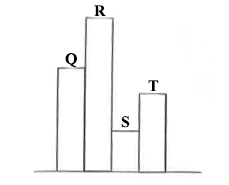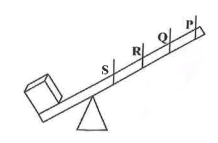
Finwaver.com
Your school or business runs better on finwaver.com. Sign up for free one (1) week try.
1.
Plants are different from animals because they
have protoplasm
have chlorophyll
are able to respire
are able to reproduce sexually
2.
Which of the following conditions is not required for a current to flow through an electric circuit?
The circuit should be closed
A battery must be present
There must be connecting wires
A bulb must be connected in the circuit
3.
Which of the following examples is a source of energy?
Electricity
Heat
Light
Wood
4.
Heat is transferred from the bottom of water in a container to the top by
conduction
convection
radiation
conduction and radiation
5.
A mercury thermometer works on the principle that
solids expand on heating and contract on cooling.
liquids expand on heating and contract on cooling.
gases expand on heating and contract on cooling.
liquids evaporate when heated to a certain temperature.
6.
In which of the positions Q,R,S,T in the diagram below will a body have the greatest potential energy?

Q
R
S
T
7.
A solar cell produces electrical energy from
electromagnets
heat
light
sound
8.
In a third-class lever the
pivot is between the load and effort
pivot is absent
load is between the effort and pivot
effort is between the load and pivot
9.
At which positions S,R,Q and P on the lever in the diagram below must a force be applied to lift the load most easily?

P
Q
R
S
10.
Which of the following machines works on the same principle as an inclined plane?
Bottle opener
Wheelbarrow
See-saw
Screw
11.
Power is defined as the
ability to do work.
force to move an object.
rate of doing work.
ability to replace energy used.
12.
Which of the following food substances is not involved in respiration?
Amino acids
Fatty acids
Glucose
Vitamins
13.
Which of the following organisms is at the beginning of a food chain?
Fish
Grass
Locust
Mosquito
14.
The human male sex cell that takes part in reproduction is the
penis
scrotum
sperm
testis
15.
The removal of waste products from the cells of organisms is called
assimilation.
circulation.
exhalation.
excretion.
16.
The central nervous system consists of the
spinal cord and spine.
brain and the nerves.
brain and the spinal cord.
skeletal system and skull.
17.
Which of the following life processes is not performed by all living things?
Excretion
Photosynthesis
Reproduction
Respiration
18.
All veins in the body carry blood that does not contain oxygen with the exception of the veins from the
heart.
kidneys.
lungs.
liver.
19.
The method of purification of water containing very little impurities is
boiling
chlorination
distillation
filtration
20.
Boiling and chlorination are used in water purification to
kill germs.
help suspended particles to settle.
remove suspended particles.
remove hardness of the water.
21.
The chemical symbol C is the symbol for
calcium.
chlorine.
carbon.
sodium.
22.
A substance which is made up of the same kind of atoms is called
a compound.
a mixture.
an element.
an ion.
23.
Which of the following processes results in the formation of new substances?
Heating camphor
Cooling water to form ice
Adding saliva to cooked yam
Mixing iron dust and sand together
24.
When elements combine to form a compound the
constituents can be separated by a physical process.
volume of the compound is the sum of the volumes of the constituents.
reaction does not involve a heat change.
reaction can be represented by a chemical formula.
25.
Which of the following organisms is likely to increase the oxygen content of the water in a pond?
Fish
Tadpole
Mosquito larva
Water lily
26.
Which of the following parasites is a plant?
Bilharzia
Dodder
Lice
Tapeworm
27.
The part of the soil that is most important for the growth of plants is
clay.
humus.
sand.
silt.
28.
Which of the following diseases may be associated with water?
Chicken pox
Cholera
Small pox
Tetanus
29.
The mosquito and housefly are harmful in that they
suck blood.
bite and cause pain.
settle on food.
spread diseases.
30.
Which of the following diseases affects the central nervous system?
Cerebro Spinal Meningitis (CSM)
Poliomyelitis
Measles
Yellow Fever
31.
Day and night occur because the earth
moves round the sun.
moves from east to west.
moves round the moon.
rotates on its axis.
32.
Bronze is an alloy of
iron and carbon.
zinc and copper.
iron and zinc.
copper and tin.
33.
Which of the following substances causes acid rain when released into the atmosphere?
Carbon dioxide
Water vapour
Sulphur dioxide
cement dust
34.
Which of the following gases helps in rusting?
Carbon dioxide
Hydrogen
Oxygen
Nitrogen
35.
The force of attraction between molecules of different substances is called
adhesion.
cohesion.
tension.
viscosity.
36.
A metal block has a mass of 0.1kg. Calculate its volume if the density is 1.0 kgm-3.
0.01 m3
0.10 m3
1.00 m3
10.00 m3
37.
The food manufactured by a plant is distributed to all parts of the plant through the
chlorophyll.
phloem.
stomata.
Xylem.
38.
Some insects are able to walk on water because
they are lighter than water.
their skins cannot be penetrated by water.
the surface of the water acts like an elastic skin.
the surface of water is curved.
39.
Oxygen is made available to all cells of the human body by the
plasma.
platelets.
white blood cells.
red blood cells.
40.
The force which pulls all objects towards the centre of the earth is the
frictional force.
electrostatic force.
gravitational force.
rotational force.